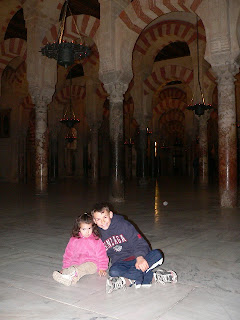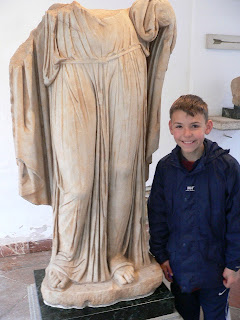Priego de Cordoba is a lifetime away from Orce. We drove by 1,000's of olive trees to get to this white-washed town that has been home to Visigoths (First kid friend to tell us about who they are wins a souvenir from Spain! CONGRATULATIONS EVAN! By the way, Maddie was the first to guess the mystery fruits were persimmons & we picked up something for her at the Archeology Museum in Orce. Great job to everyone who tried and great job to Maddie for being fast as the wind in her answer!). Priego de Cordoba was also home to the Moors and later became very wealthy because of the silk trade during the 18th Century.
We're staying in the old Arab Quarter at La Posada Real with our wonderful host, Juan.
There are orange trees, fountains, and endless narrow alleyways that wind by beautiful wooden doors and potted geranium plants. Our place is located along a narrow, cobbled passageway that is so small you can almost stretch your arms across and touch; it's way too small for cars. We'll post more on Priego soon but wanted to show you where we went today--- a place that was both a Roman and Muslim capital, a place that has been described as one of the most important cities in all of Europe in the 11th Century---the city of Cordoba. It has been said that Cordoba was rival to Baghdad and Cairo- that gives you a sense how OLD Cordoba is doesn't it?
One of the things that makes Cordoba so unusual and fascinating is that Jews, Moors and Christians lived together side by side in peace over 1,000 years ago. History drips from Cordoba. We parked our car and walked over a real Roman bridge.
Right in front of us was a monument we've all been anxious to see, even Baby-O--- because of a book we've been reading every single day since Christmas:

They were, literally, sweeping the oranges away.
The outside of the monument was as beautiful as the inside:
When the Catholic monarchs took over the city (I won't ruin the story) the Mezquita was saved but Catholic art, architecture and its footprint were firmly placed into the structure. I'm Catholic, and maybe it was seeing the tomb of the Bishop of the Inquisition (parents' I'll let you take that one) that made me feel less proud as I probably should've seeing the 'Cathedral' part of the Cathedral-Mosque, but whatever it was I only tool one picture of the 'new' part because it just didn't feel right.
You're looking at solid gold. We saw many, many, may solid gold and silver pieces. They were beautiful to be sure, but my Dad captured it when he softly muttered, 'You're looking at blood, sweat and tears from the New World.'
The Spanish Empire was one of the largest empires in world history. Remember Columbus' journey of discovery funded by Ferdinand and Isabel? As you find in life, there's always two sides to a story and what was victory for Spain was brutality for native peoples. Thousands of indian laborers would die in Latin America mining silver and gold which would be transported to a Spanish Main (what's that?) and sent back home.
I've read about it. I've studied it. I've even visited a lot of the places in Latin America that provided the riches but today I realized just how much wealth it provided and it made me sad, not awe-struck. I stood next to a group of Germans as we admired a solid gold sculpture that was as tall as a grown man; one German uttered breathlessly, 'amazing isn't it?' but luckily he wasn't really waiting for my answer.
J really put it nicely when he said yesterday, "As one civilization crumbles another rises." The great thing about Cordoba is that its history of tolerance, unity and leadership really permeates the city. It had an elegant grace about it that just felt great. It is an easy city to be in and left us longing for more.
Seeing Roman columns and Roman sculptures in this beautiful city were a thrill. Roman work/art is breathtaking for its beauty and absolutely one-of-a-kind for its design style.
We can't wait to see Roman ruins that lie ahead in coming weeks.
Our day trip to Cordoba left me thinking about how when you travel for a while at a time you're able to get a pulse on the 'soul' of a place pretty quickly through the people you meet, the things you see, the food you taste and the way you either want to push on or linger. It's not a short jump to then think about your own style, your own habits, your own ways (when you're traveling as a group of 7 hopefully each of us is pondering this!)--- what's your soul like? Do you make people want to linger or to push on? Would we have the kindness and vision to save the Mezquita instead of destroy it if we were the 'winners'? Are we welcoming and easy going? Or, do we bristle? Cordoba definitely shows the way to graciousness in spades---I hope to be Cordoba in spirit as much as possible.
Oh! One last thing-- tonight when we read The Most Magnificent Mosque we traced the lines of the arches in the mosque and pointed at the oranges as we do every night but today was different, for Baby-O kept exclaiming, 'Hoy! Hoy! Hoy!' which means, 'Today.'


























I could have stayed all day in the Mezquita meditating - in awe of the beauty... the countless columns that felt like you were sitting in a palm forest in a desert oasis... feeling connection to spirit by feeling the awe of the magnificent architecture... So great to read your descriptions and see your photos... sending love to you and all!
ReplyDelete